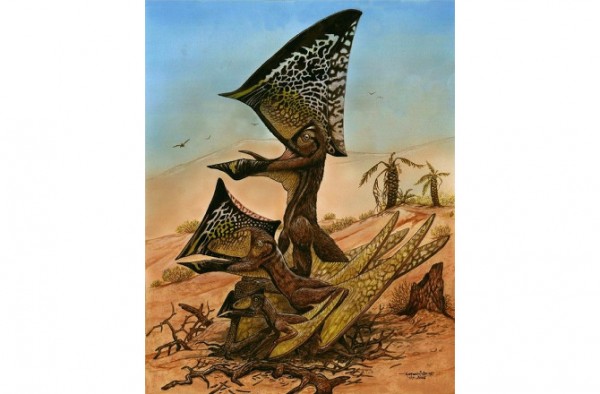Prehistoric "Butterfly-Headed" Flying Reptile Fossils Found in Brazil
| Dino Lirios | | Aug 14, 2014 05:10 AM EDT |
(Photo : Maurilio Oliveira / Museu Nacional - UFRJ) A new species of flying reptile from the Cretaceous Era, Caiuajara dobruskiii, has been unearthed in Southern Brazil
Ancient reptile fossils recently unearthed in Southern Brazil belonged to a flying reptile with a "butterfly-like head."
"Caiuajara dobruskii," the name of this brand-new species of reptile, was said to have lived about 80 million years ago in an ancient desert oasis. Their heads were shaped like a butterfly's wings, and the reptile had a wingspan that allowed them to take flight from an early age.
Like Us on Facebook
The presence of hundreds of fossils in a single bone bed is significant, meaning the flying reptiles were social in nature, said Alexander Kellner, a paleontologist at the Museu Nacional / Universidade Federal do Rio de Janeiro in Brazil.
Kellner said that the bone bed, with its hundreds of individual fossils in well-dated geological layers, is some of the strongest evidence yet the fruit-eating animals were social.
This may, in turn, strengthen evidence that other pterosaur species may have been social, as well.
The bone bed was originally found in a geologic formation called the Caiuá Group. This is the first time that significant findings were brought to light in the southern half of the country. On the other hand, it's common to find pterosaur fossils in Northern Brazil.
In the 1970s, a farmer discovered a massive Cretaceous Period bone bed in Southern Brazil. The region was not known for any fossils, and the discovery was forgotten and only recently rediscovered.
Hundreds of bone fragments from the new pterodactyl species were found in an area 20 square meters large. Adult and juvenile fossils were found, with the young having wingspans reaching 0.65 meters and the adult wingspans reaching 2.35 meters in length.
Since there was no glaring difference between the skeletal sizes of the adults and the younger ones (apart from the head), researchers hypothesized that Caiuajara dobruskii could fly at a young age.
Researchers inferred the possibility that ancient colonies may have lived around the lakes for water supplies and died during periods of drought and storms. Their remains would have been pushed into the lake where the water preserved their fossils indefinitely.
TagsButterfly head, Fossils
©2015 Chinatopix All rights reserved. Do not reproduce without permission
EDITOR'S PICKS
-

Did the Trump administration just announce plans for a trade war with ‘hostile’ China and Russia?
-

US Senate passes Taiwan travel bill slammed by China
-

As Yan Sihong’s family grieves, here are other Chinese students who went missing abroad. Some have never been found
-

Beijing blasts Western critics who ‘smear China’ with the term sharp power
-

China Envoy Seeks to Defuse Tensions With U.S. as a Trade War Brews
-

Singapore's Deputy PM Provides Bitcoin Vote of Confidence Amid China's Blanket Bans
-

China warns investors over risks in overseas virtual currency trading
-

Chinese government most trustworthy: survey
-

Kashima Antlers On Course For Back-To-Back Titles
MOST POPULAR
LATEST NEWS
Zhou Yongkang: China's Former Security Chief Sentenced to Life in Prison

China's former Chief of the Ministry of Public Security, Zhou Yongkang, has been given a life sentence after he was found guilty of abusing his office, bribery and deliberately ... Full Article
TRENDING STORY

China Pork Prices Expected to Stabilize As The Supplies Recover

Elephone P9000 Smartphone is now on Sale on Amazon India

There's a Big Chance Cliffhangers Won't Still Be Resolved When Grey's Anatomy Season 13 Returns

Supreme Court Ruled on Samsung vs Apple Dispute for Patent Infringement

Microsoft Surface Pro 5 Rumors and Release Date: What is the Latest?










